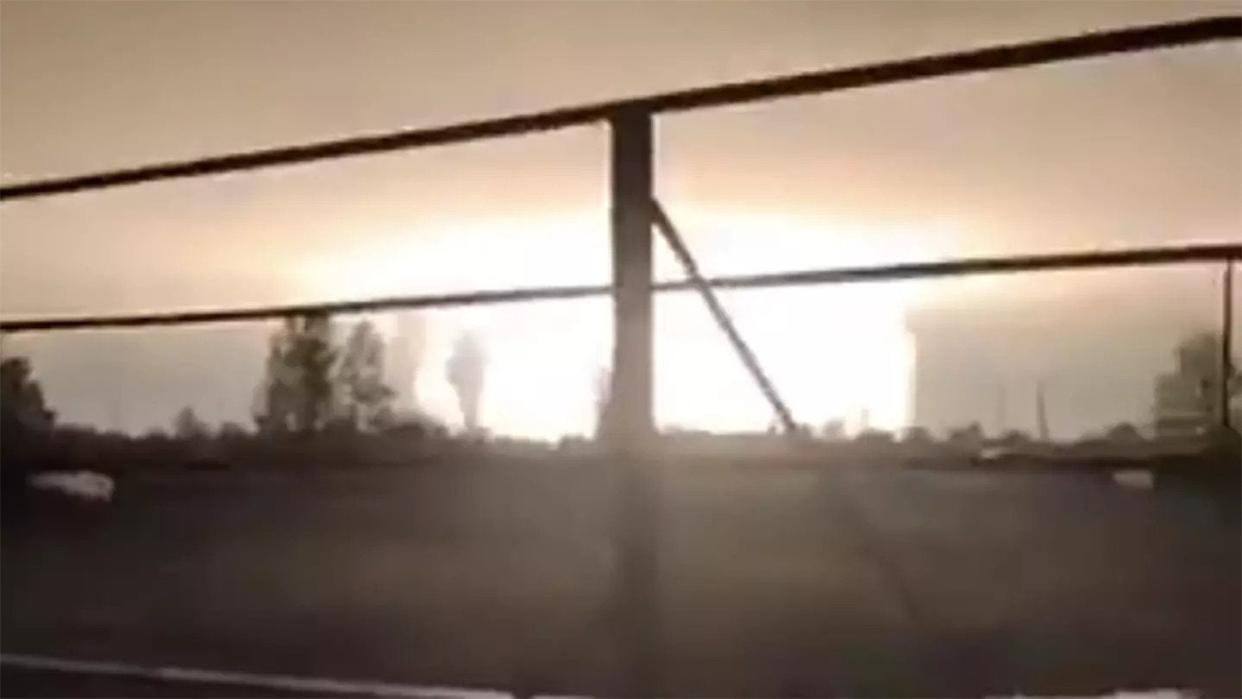Massive Shockwave From Russian Strike May Have Been A Rocket Storage Facility Detonating

The massive explosion and ensuing shock wave seen in video from the Ukrainian city of Pavlograd in Dnipropetrovsk Oblast was most likely the result of a giant secondary detonation. What seems to have been hit, although not confirmed as of yet, was a plant that is used for missile fuel and other highly volatile explosive applications. The facility has been a cause of great concern for locals in the past.
Ukraine claims it downed 15 of 18 Russian cruise missiles launched by Tu-95MS Bear-H strategic bombers, but three missiles apparently evaded air defenses. Videos posted on social media after the Russian barrage show explosions and their aftermath brightly lighting up the night sky.
https://twitter.com/Capt_Navy/status/1653034719502643202 https://twitter.com/DefMon3/status/1652771900198723593 https://twitter.com/Faytuks/status/1652762984727429127
Ukrainians say a residential area and an industrial complex were hit while Russians claim that Ukrainian supplies for its looming counteroffensive were targeted.
“An industrial enterprise was damaged in Pavlograd," Serhiy Lysak of the Dnipropetrovsk Oblast Military Administration said Monday on his Telegram channel. “A fire broke out there, which the rescuers have already put out. In the residential area, 19 high-rise buildings, 25 private houses, six schools and pre-school education institutions, and five shops were mutilated.”
There were also dozens of buildings in the surrounding communities damaged as well, Lysak said, including almost 40 residential buildings In Verbkivska. It was the second devastating Russian missile strike on Ukraine in the past several days. More than 20 civilians, including at least four children, were killed Friday in the first mass Russian attacks on Ukrainian cities in more than a month, officials in Kyiv said last week.
More than 30 people were injured and dozens of buildings were damaged or destroyed by a Russian missile strike on Pavlograd. (Serhiy Lysak Telegram channel photo)
The Russians, meanwhile, say they were targeting military facilities.
“The Armed Forces of the Russian Federation launched a long-range high-precision air and sea-based missile strike against Ukrainian military-industrial complex facilities,” the Russian Defense Ministry (MoD) reported on its Telegram channel Monday. “The goal of the attack has been reached. All the assigned targets have been neutralized. The enterprises producing ammunition, weapons and military equipment for Ukrainian forces have been disrupted.”
The city is strategically located in an area through which that counteroffensive drive toward Crimea could take place, a route we examined in December.
Pavlograd is located on one possible route for a Ukrainian counteroffensive toward Crimea. (Google Earth image)
But it is also home to the Pavlograd Chemical Plant. That’s where fuel for Ukrainian missiles is produced, according to Euromaidan Press.
"The plant participates in tests of the rocket firing system with corrected 'Alder-M' [guided rockets] and anti-ship cruise missile Neptune," according to the Ukrainian Dnipr Bridge media outlet. Domestically produced Neptune missiles were used to sink the Russian Navy’s Project 1164 Slava class cruiser Moskva. You can read about the Alder-M, known by its Ukrainian name Vilkha-M, in our deep dive here.
— Capt(N) (@Capt_Navy) May 1, 2023
The plant is also where old Soviet-era SS24 ICBMs were stored and ultimately supposed to be dismantled as part of the Defense Department’s (DoD) Cooperative Threat Reduction (CTR) program. Also known as the Nunn-Lugar program, the CTR was created “for the purpose of securing and dismantling weapons of mass destruction (WMD) and their associated infrastructure in the former states of the Soviet Union,” according to the U.S. State Department.
found a youtube clip of a ukrainian TV channel's report on the facility that seemingly got struck: https://t.co/3WHl1clNy2
— Matthias R (@MatthiasReitner) May 1, 2023
The Defense Threat Reduction Agency said it completed the provision of technical assistance to the State Space Agency of Ukraine and Pavlograd Chemical Plant in December 2018 to: “safely store SS-24 loaded solid motor cases; support the safe removal of propellant; and deliver and commission a complex Eisenmann incinerator to eliminate empty motor cases.”
In 2020, the BBC reported on local residents’ concerns about what would happen if the plant were to explode, with some people calling it a “ticking time bomb” where more than 1,800 tons of expired rocket fuel was stored.
"If we already have a strategic facility in the city with a large amount of explosive fuel, then under no circumstances should the disposal process be stopped,” Svitlana Shaperenko told the BBC at the time. “We're just a ticking time bomb. If there's an explosion, that's the end.”
The administrative building of the Pavlograd Chemical Plant as photographed in 2020. (Mykola Miakshykov / Ukrinform/Future Publishing via Getty Images)
Old ICBMs aren’t the only explosive items stored at Pavlograd.
The facility is also used to store part of the 55 million stockpiled antipersonnel landmines designated for destruction under the Mine Ban Treaty, according to the International Campaign to Band Land Mines (ICBL).
“In Ukraine, we regret that has been no stockpile destruction since 2020 and the end of an agreement between Ukraine’s Ministry of Defense and NATO’s Support and Procurement Agency to destroy the remaining stockpiled mines at the Pavlograd Chemical Plant,” ICBL stated in November 2022.
What appears to be a large storage facility to the north of the town could have been targeted, although the plant has extensive facilities in the city. We are working to clarify this. (Google Earth)
Whatever the case, the explosions in the town of Pavlograd were remarkably powerful. Obviously, any production capability for rocket propellant would be a prime target for Russian forces, but a storage area with large decommissioned rockets could have presented a huge secondary explosive potential that Russia specifically pursued.
As of now, cloud cover has made commercial satellite imagery impossible to obtain, so we can't see exactly what was struck or the extent of the damage. We will update this post when we find out more.
Contact the author: howard@thewarzone.com

